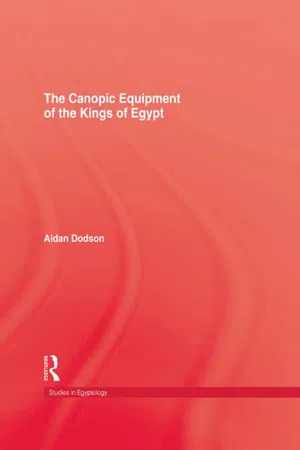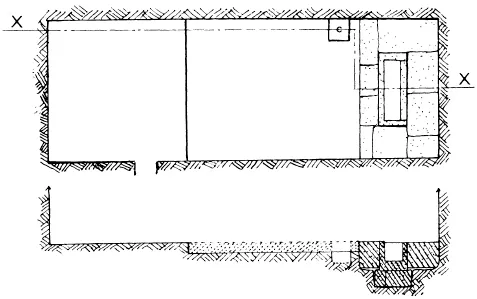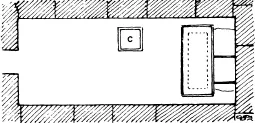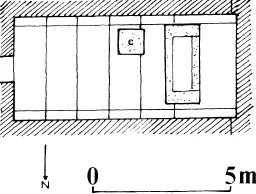
- 286 pages
- English
- ePUB (mobile friendly)
- Available on iOS & Android
eBook - ePub
The Canopic Equipment Of The Kings of Egypt
About this book
First published in 1994. The term 'Canopic', as applied to the containers employed by the Egyptians to contain the embalmed internal organs of the deceased, derives from a case of mistaken identity. The aims of this monograph are primarily archaeological and historical, to document all canopic equipment attributable to the kings of Egypt, and to discuss each element in its spatial and temporal context. Translations of all available texts are provided, but no attempt is made to discuss them from a detailed religious or philological standpoint.
Frequently asked questions
Yes, you can cancel anytime from the Subscription tab in your account settings on the Perlego website. Your subscription will stay active until the end of your current billing period. Learn how to cancel your subscription.
No, books cannot be downloaded as external files, such as PDFs, for use outside of Perlego. However, you can download books within the Perlego app for offline reading on mobile or tablet. Learn more here.
Perlego offers two plans: Essential and Complete
- Essential is ideal for learners and professionals who enjoy exploring a wide range of subjects. Access the Essential Library with 800,000+ trusted titles and best-sellers across business, personal growth, and the humanities. Includes unlimited reading time and Standard Read Aloud voice.
- Complete: Perfect for advanced learners and researchers needing full, unrestricted access. Unlock 1.4M+ books across hundreds of subjects, including academic and specialized titles. The Complete Plan also includes advanced features like Premium Read Aloud and Research Assistant.
We are an online textbook subscription service, where you can get access to an entire online library for less than the price of a single book per month. With over 1 million books across 1000+ topics, we’ve got you covered! Learn more here.
Look out for the read-aloud symbol on your next book to see if you can listen to it. The read-aloud tool reads text aloud for you, highlighting the text as it is being read. You can pause it, speed it up and slow it down. Learn more here.
Yes! You can use the Perlego app on both iOS or Android devices to read anytime, anywhere — even offline. Perfect for commutes or when you’re on the go.
Please note we cannot support devices running on iOS 13 and Android 7 or earlier. Learn more about using the app.
Please note we cannot support devices running on iOS 13 and Android 7 or earlier. Learn more about using the app.
Yes, you can access The Canopic Equipment Of The Kings of Egypt by Aidan Dodson in PDF and/or ePUB format, as well as other popular books in Historia & Historia antigua. We have over one million books available in our catalogue for you to explore.
Information
Part One
CHAPTER ONE
THE OLD KINGDOM
THE earliest surviving evidence for the artificial preservation of the dead body in Egypt dates to the Archaic Period.1 While it is probable that the removal of the internal organs played a major rôle in this from the outset, unequivocal evidence for their separate preservation is not found until the time of Kheops.2 However, architectural arrangements that appear to have been intended to accommodate wooden canopic chests may be identified in certain Second/Third Dynasty tombs at Saqqara and other sites.3
None of the Archaic Period royal tombs at Abydos4 seems to have preserved any evidence relating to canopiec, but their devastated condition means that no realistic conclusions can be drawn from this. The great complex of Djoser, on the other hand, possesses a number of architectural features that could be regarded as the location of possible canopic installations.
One particularly interesting suggestion is that one of each of the pairs of calcite sarcophagi which had lain in Galleries I-V below the east side of the Step Pyramid was intended for canopic use.5 The argumentation invokes the four allegedly canopic jars found in one of two calcite sarcophagi, identical to those under the pyramid, found at Dahshur inside the enclosure of Sesostris III.6 However, it seems most probable that the tomb in which they were found dates to the Middle Kingdom, their reuse there making them of no value in the present discussion.7
Most speculation has, however, centred on the South Tomb.8 This structure, built into the southern enclosure wall of the temenos, duplicates the main features of the Step Pyramid substructure on a smaller scale,9 with a burial chamber generally felt as being, at 160 cm square, too small to contain a body.10 In its position, south of the main tomb, and in the relative scale of the substructure, the mastaba-form South Tomb parallels later subsidiary pyramids. The first is found at Meidum at the end of the Third Dynasty, and the last in Twelfth Dynasty complex of Sesostris I at Lisht. While one cannot be certain in the matter, it seems reasonable to assume that the South Tomb is the prototype for these later structures. Accordingly, they ought to shed some light on the purpose of the earlier monument.
Unfortunately, the subsidiary pyramids themselves have provided little or no evidence on which to base an assessment of their purpose.11 Nevertheless, it is quite clear that they were not intended to house the viscera, given that canopic chests lay within the burial chambers of many main pyramids possessing subsidiaries, beginning with Khephren (q.v.).12
An alternative location for canopiecs might be sought amongst the great complex of passages that surround the burial chamber of the Step Pyramid itself, but none appears to have a location or form that would suggest that they were intended to hold Djoser’s viscera. Perhaps any canopic packages were placed alongside the mummy within the king’s rather unusual sepulchral chamber, whose form does not admit the use of a separate sarcophagus.13
The substructure of the pyramid of the Horus Sekhemkhet, Djoser’s probable successor, contained an empty sarcophagus, the meaning of which has been much discussed. In the burial chamber, tall niches exist both south-east and south-west of the sarcophagus;14 although no remains were found, one of these might have been intended to be canopic.
The Layer Pyramid at Zawiyet el-Aryan15 is normally placed directly after that of Sekhemkhet, and attributed to the Horus Khaba.16 Its substructure does not seem to have included potential canopic elements, nor does that of the Unfinished Pyramid at the same site.17
The same is true for what seem to have been the last two pyramids of the dynasty.18 The Brick Pyramid at Abu Roash19 has a simple, square, burial chamber, while the rectangular apartment of the pyramid of Meidum20 lacks any trace of arrangements for a sarcophagus/coffin or canopic chest; two 2.5 metre square niches lie in the approach corridor, but their number and location, north of the burial chamber, argue against any canopic rôle.21
Following the uncertainties of the Third Dynasty, tombs spanning its end and the beginning of the Fourth contain features that can be identified as canopic with some confidence: in a series of private tombs at Meidum niches occur at a high level in the south walls of a number of sepulchral chambers, in most cases, including those of Nefermaet and Rehotpe, at the eastern end.22 This position in the south-eastern corner of the burial chamber becomes the standard location of canopic installations in the slightly later Fourth Dynasty private tombs at Giza. These commonly comprise rectangular pits or wall-recesses, closed by limestone slabs, the pits occurring rather more frequently.23 No traces survive of the putative inner containers.
The most important evidence for the preservation of the viscera, and the earliest unequivocal item of canopic equipment, is the calcite chest of Queen Hetepheres, from Giza G7000X (plate la),24 which still contained the remains of apparent canopic packages. These lay at the bottom of each of the chest’s four square compartments, wrapped in linen and immersed in a 3% natron solution.25 The closed box, around which a sealed cord was passed, lay in a niche, cut at ceiling level at the south end of the west wall of the burial chamber.26
The developed form of Hetepheres’ stone chest might suggest some previous evolution, but no earlier example is extant. Indeed, chests carved from single blocks are otherwise known to begin in the Fifth Dynasty.27 During the Fourth Dynasty we have a handful of chests built from slabs which are, however, more in the nature of upward extensions of floor cavities.28 Canopic jars, in stone or pottery, make their appearance at the very end of the Fourth Dynasty. The earliest examples are also from the funerary outfit of a queen, in this case Meresankh III.29

FIGURE 1a. Plan and section of burial chamber of Giza GII (Khephren).

FIGURE 1b. Plan of burial chamber of S.Saqqara L.XXXVII (Isesi).

FIGURE 1c. Plan of burial chamber of Saqqara L. XXX (Teti).
Given that his wife possessed a canopic chest, one might have expected some form of box in the tomb of King Seneferu. However, nothing survives in the Northern Stone Pyramid at Dahshur, where he was very probably buried,30 although a built sarcophagus and/or box may have been obliterated when the whole floor of the burial chamber was destroyed in antiquity.31 Such a box is to be found in the floor of the sepulchral chamber of the Second Pyramid of Giza (Cat. 1); it is cut hard against the south wall of the chamber, south-east of the sarcophagus (plate Ib, figure la). The lower part is cut from the bed-rock, the upper half formed out of the (now missing) limestone paving of the room. On the basis of private parallels, it is unlikely that any further stone chest lay within the cavity. In all probability, the king’s viscera were housed within a wooden container.32
Such an installation cannot be identified in the burial chambers of Kheops and Mykerinos, nor any other feature that could be interpreted as canopic.33 It has been suggested that no cavity was sunk in these pyramids because of the granite paving of their sepulchral chambers, in contrast to Khephren’s limestone.34 Of the other two certain Fourth Dynasty kings’ tombs, the burial chamber of Djedefre’s Abu Roash monument has never been properly investigated. The floor of the tomb chamber of Shepseskaf’s Mastabat Fara’un was removed in antiquity.35 With it may have gone a built chest of the kind found in the Second Pyramid and the Giza private tombs noted above.
It is distinctly unfortunate that the sepulchral apartments of the pyramids of the first part of the Fifth Dynasty are either incompletely examined (Userkaf,36 Menkauhor37), totally devastated (Abusir pyramids of Sahure, Kakai, Neferefre, Niuserre38) or uncertainly identified (Shepseskare?39), so that it is not possible to comment on the canopic arrangements adopted therein. The earliest example available for examination is that of Isesi, which is a cavity sunk into the three courses of limestone blocks that form the flooring of the burial chamber (Cat. 2). Its position, directly opposite the southern end of the eastern face of the sarcophagus, is that employed for the rest of the Old Kingdom and differs only marginally from that ...
Table of contents
- Cover
- Halftitle
- Title
- Copyright
- Dedication
- Contents
- Preface
- List of Plates
- List of Figures
- Abbreviations
- Introduction
- Part I
- Part II
- Bibliography and List of Works Cited
- Indexes
- Plates